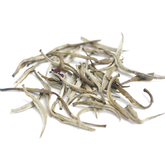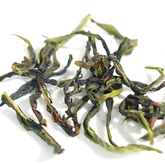Complete Introduction to Chinese Green Tea and the Best Green Teas
Green tea is the only non-fermented tea among the six major tea types . Its processing method allows it to retain more of the natural substances found in fresh leaves, resulting in its characteristic "clear soup and green leaves, fresh and pleasant" features. The process of making tea is one of the key factors in classifying the six major tea types, which include green tea, yellow tea, black tea, white tea, oolong tea, and dark tea.
 Green tea is made by fixing the tea leaves to deactivate the tea polyphenol oxidase, keeping the leaves and the tea soup green.
Green tea is made by fixing the tea leaves to deactivate the tea polyphenol oxidase, keeping the leaves and the tea soup green.
History of Chinese Green Tea
The history of green tea dates back thousands of years to China's Tang Dynasty. According to legend, the discovery of green tea is attributed to China's Shennong, who accidentally dropped tea leaves into boiling water and found the taste enchanting, thus inventing tea. Around 2000 BC, green tea began to be widely consumed by ancient Chinese nobility and scholars, gradually becoming a common beverage.

Over time, the cultivation and processing techniques for green tea have improved, and the varieties of tea have become more diverse. By the Tang Dynasty (618-907 AD), green tea had become a major drink among the imperial court and the upper class, playing an important role in cultural and religious activities. During the Song Dynasty (960-1279 AD), the tea ceremony emerged, and drinking tea evolved into an art form, leading to significant development in tea culture.
Matcha is a special form of green tea, with its processing method originating from the Tang Dynasty but perfected during the Song Dynasty. Matcha is made from tender tea buds that are steamed and then ground into a fine powder. Initially, matcha was mainly consumed in temples as part of Zen Buddhist practices. It was not until the 14th century that matcha was introduced to Japan from China, where it developed into an important cultural tradition within Japanese tea ceremonies.

Flavor Profile of Green Tea
Green tea is renowned for its refreshing and crisp taste, with a subtle grassy and floral aroma that provides a natural cooling sensation. The tea soup is fresh and not bitter, with a hint of sweetness and a lingering, pleasant aftertaste. The taste of green tea is light and elegant, smooth and delicate, evoking the feeling of being among springtime foliage.

In China, spring is considered the best time to enjoy green tea due to its optimal flavor and quality. Additionally, green tea has a relatively low caffeine content, making it a better choice for those who need to limit their caffeine intake.
Types of Green Tea (by Processing Method)
China, the birthplace of tea, has a mature tea-making process. The basic processing steps for Chinese green tea are fixing, rolling, and drying. Based on the fixing and drying methods, the common green tea types are “steamed green tea,” “pan-fired green tea,” “sun-dried green tea,” and “baked green tea.”
Pan-Fired Green Tea
Pan-fired green tea is made by fixing and drying the tea leaves using a rolling drum or pan. It has a tight appearance, green luster, high fragrance, clear green liquor, and a strong and refreshing taste. Pan-fired green tea is the most widely produced and can be further categorized into long-fired, round-fired, and flat-fired types.

Baked Green Tea
Baked green tea is dried using an oven or drying machine. It has a complete shape, deep green color with an oily sheen, high fragrance, clear and bright liquor, and a fresh and mellow taste.
Steamed Green Tea
Steamed green tea is the earliest method of processing green tea in China, using steam to fix the fresh leaves before rolling and drying. It has a fine, needle-like shape, bright or deep green color with a sheen, clear liquor with a light yellow-green hue, a fresh aroma, and a mellow or slightly astringent taste.

Sun-Dried Green Tea
Sun-dried green tea is dried using sunlight. It has a coarse shape, dark green color with an oily sheen, high fragrance, bright yellow-green liquor, and a rich and mellow taste with strong astringency. It is mainly produced in Hunan, Hubei, Guangdong, Guangxi, Sichuan, Yunnan, and Guizhou provinces.
Common and Best Chinese Green Teas
Longjing Tea (西湖龙井)
The top among China's ten famous teas. Longjing tea leaves are dark green with a rich fragrance, and the tea soup has a sweet taste.
Major Production Area: West Lake, China.
Flavor: Mingqian Longjing is fresh and sweet with a smooth texture; Yuqian Longjing has a rich aroma and smooth, mellow taste.
Suitable for: Beginners and experienced tea drinkers who enjoy strong flavors
Anji White Tea(安吉白茶)
Named after a tea tree with white buds, it is actually a type of green tea.
Major Production Area: Xilong Township, Kuntong Township, and Dipu Town in Anji County, Zhejiang Province, China.
Flavor: Fresh and tender, with a sweet aftertaste.
Suitable for: Tea beginners.
Biluochun Tea(碧螺春)
With a history of over a thousand years, originally known as Dongting tea.
Major Production Area: Dongting Mountains in Jiangsu Province, China.
Flavor: Fresh and sweet with strong floral and fruity notes.
Suitable for: Those who appreciate floral aromas.
Huangshan Maofeng(黄山毛峰)
Created during the Qing Dynasty, known for its pointed tips and white hairs.
Major Production Area: Huangshan Scenic Area and surrounding regions in Anhui Province, China.
Flavor: Sweet and mellow with a fragrant aroma.
Suitable for: Tea lovers who enjoy rich flavors.
Taiping Houkui(太平猴魁)
A traditional tea from Tai Ping County, Anhui Province, with a unique flat and straight leaf shape.
Major Production Area: Monkey Peak, Monkey Hill, and Yanjia in Huangshan, Anhui Province, China.
Flavor: Orchid-like aroma with a rich and refreshing taste.
Suitable for: Those who enjoy light flavors and strong aromas.
Liu'an Guapian(六安瓜片)
A premium tea from Liu'an tea.
Major Production Area: Liu'an City, Anhui Province, China.
Flavor: Refreshing and thick, with a pleasant aftertaste.
Suitable for: Those who enjoy rich flavors.
Xinyang Maojian(信阳毛尖)
Also known as Yumaofeng, named after high-quality Maojian tea from Xinyang tea area.
Major Production Area: Shihe District, Dongjiahe Town, and Tanhe Village in Xinyang, Henan Province, China.
Flavor: Strong and mellow with a lingering aftertaste.
Suitable for: Those who enjoy bold flavors.
Lushan Yunwu(庐山云雾)
Originally a wild tea, later cultivated by Buddhist monks.
Major Production Area: Lushan, Jiangxi Province, China.
Flavor: Fresh and long-lasting with a mellow taste.
Suitable for: Those who appreciate rich flavors and a strong aftertaste.
How To Make Green Tea Shots?
When brewing green tea, ensure the water temperature is not too high, and avoid steeping for too long to prevent bitterness. (Expand Reading: Mastering The Art Of Brewing Chinese Tea)

1.Prepare a clear glass cup (about 200–300ml)
2.Add around 3 grams of green tea leaves (about one teaspoon)
3.Pour a small amount of warm water (around 80°C / 175°F) to rinse the leaves, gently swirl, then discard the water
4.Refill the glass with warm water up to 70% full
5.Steep for 1 minute, then enjoy
6.You can refill 2–3 times as the leaves open up
✅ Tip: Use lower temperature water to avoid bitterness.
✅ Top up the water promptly to maintain the best flavor.
What Is Green Tea Good For?
Green tea is one of the most popular teas in the world. Beyond its refreshing taste, it has been widely studied for its health benefits. Here are some science-backed advantages of drinking green tea:
Rich in Antioxidants
Green tea is packed with polyphenols, especially a powerful compound called EGCG (Epigallocatechin gallate). These antioxidants help fight free radicals and reduce cell damage. According to Harvard T.H. Chan School of Public Health, the antioxidants in green tea may lower the risk of chronic diseases.(Source: Harvard T.H. Chan School of Public Health, “Tea”)
Supports Heart Health
Studies have shown that regular consumption of green tea is linked to a reduced risk of heart disease and stroke. Research published in the Journal of the American Heart Association found that green tea can improve cholesterol levels and blood pressure, helping protect cardiovascular health.(Source: Journal of the American Heart Association, 2013)
Helps with Weight Management
The caffeine and polyphenols in green tea can boost metabolism and increase fat burning. A study from the University of Tokyo found that green tea extract supports weight control and fat oxidation.(Source: The American Journal of Clinical Nutrition, 1999)
May Reduce Cancer Risk
Some research suggests that the antioxidants in green tea could help lower the risk of certain cancers, including breast, prostate, and colorectal cancer. The National Cancer Institute (NCI) notes that while more studies are needed, the potential protective effects of green tea are promising.(Source: National Cancer Institute, “Tea and Cancer Prevention”)
Improves Brain Function
Green tea contains caffeine and an amino acid called L-theanine, which together can improve focus, alertness, and mood. A study from the University of Basel in Germany found that green tea extract was linked to better brain connectivity and cognitive performance.(Source: Psychopharmacology, 2014)
Does Green Tea Stain Your Teeth?
From a scientific perspective, the tannins in tea are the main cause of teeth staining. Studies have found that tannins bind to the proteins in your tooth enamel and dentin, gradually forming a pigment buildup that makes teeth look yellow or dark.
Coffee and red wine work in a similar way, but tea often has a higher tannin content, which makes stains more likely to stick. However, the effect of Chinese green tea is much less than that of black tea or coffee. This is because green tea is the least fermented type of tea, has a lighter color, and contains fewer staining pigments.
As long as you maintain good brushing and rinsing habits, drinking green tea will likely not cause any noticeable teeth staining. In fact, multiple oral health studies suggest that drinking green tea in moderation can actually benefit your oral hygiene and gum health.
How to Choose High-Quality Chinese Green Teas
Check the shelf life. When choosing green tea, the most important rule is freshness. While green tea usually doesn’t spoil like food, its aroma and flavor are at their best when fresh. If stored too long, it can lose its fragrance and even develop a stale taste.

Spring tea is the best. Green tea picked in spring is usually the highest quality. The leaves are tender, rich in nutrients, and produce a fresh, smooth taste with a delicate fragrance. Green tea from other seasons is generally not as good.
Avoid broken tea. Premium Chinese green tea is often handmade, with whole, unbroken leaves, tight shapes, and a bright color. Low-quality teas, especially broken leaves or tea dust, tend to taste bitter and unpleasant after brewing.
Start with samples. At NPTEA, we recommend trying small samples first. Once you find a flavor you enjoy, you can buy a larger pack with confidence, ensuring you get green tea that truly suits your taste.
How to Store Chinese Green Teaa?
Green tee is especially sensitive to oxidation, so proper storage is very important.
Refrigerate for freshness:
Store green tea in the refrigerator to slow down oxidation and keep its fresh aroma and taste.
Drink it quickly:
Green tea tastes best when it’s fresh. The longer it’s stored, the more it loses its fragrance and flavor. Try to enjoy it within its shelf life.
Seal tightly:
Use airtight containers or bags and remove as much air as possible. This helps preserve the tea’s delicate fragrance.
Keep away from moisture and light:
Green tea should be kept in a dry, cool place, away from humidity and direct sunlight, to prevent it from losing quality.
FAQs about Chinese Green Tea
Q1: Does green tea have caffeine?
Yes, but much less than coffee.
Q2: What are the health benefits of green tea?
It's rich in antioxidants, which are good for your heart and brain.
Q3: Can green tea help you lose weight?
Yes. Its catechins and caffeine can help boost your metabolism.
Q4: What is the difference between green tea and matcha?
Matcha is powdered green tea, so you consume the whole leaf, giving you more nutrients and caffeine.
Q5: How do you brew green tea?
Use hot, not boiling, water and steep for just 1-2 minutes to avoid bitterness.
Q6: Does green tea cause teeth staining?
Its tannins can cause minor stains, but far less than coffee or black tea. Good dental hygiene will prevent most stains.
Q7: Is it safe to drink green tea during pregnancy?
In moderation, yes. It's always best to consult with your doctor.
Q8: Does green tea help with bloating?
Yes. It's a mild diuretic that can help reduce water retention.
SEE MORE LOOSE LEAF TEA
If you are a beginner about Chinese tea:
Basic-Guide-to-Chinese-Tea
If you have questions about selecting tea:
Learn-more-about-chinese-tea
If you have questions about the benefits of tea:
Health-benefits-of-chinese-tea
If you have questions about brewing tea:
How-to-brew-loose-leaf-tea






